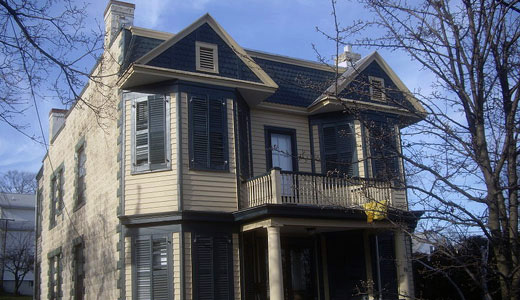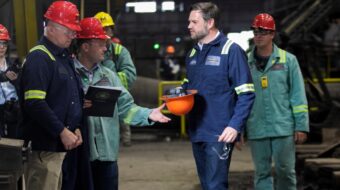
PATERSON, N.J. – On Sept. 2, the 21st annual Labor Day Parade took place in Paterson, New Jersey, a former factory town that has been, for decades, plagued with crime, poverty, and substance abuse. The People’s Organization for Progress, a nonprofit grassroots organization fighting for racial and economic justice, took the opportunity to lead a protest against unemployment, street violence, and other issues their community faces every day.
Those wishing to join in the demonstration could take a free bus at the Paterson Museum in the late morning. Protesters arrived at the Botto House Labor Museum in nearby Haledon, N.J., and marched from there back to the museum in Paterson.
The day before, a bus rider named Eddie spoke with the People’s World about the ongoing problem of joblessness that bedevils Paterson. “I’ve been living here for years,” he remarked, “and I’ve seen it go further and further downhill. That’s because there’s no jobs, and people aren’t getting together to fight for them. If your boss says you can’t join a union and you back down and say, ‘okay,’ and nobody fights back, it’s gonna hurt you. Paterson needs more people with a voice.”
According to Paterson resident Rev. Stafford Miller, of a local church called the St. Phillips Ministry, the signs of poverty are evident everywhere in the city, but some people seem to ignore them. A mural on the wall of an abandoned building was completed under Miller’s guidance, the Alternative Press reports, and is dedicated to the tragic death of a local 18 year-old who was gunned down last year.
The mural, which shows both a burial scene and a classroom scene, and includes inspirational quotes, “is part of the community, like the people,” said Miller. “It’s part of our journey, and part of our past, present, and future. It’s something in this community that gives hope.”
Turhaun Gunthrope, 36, lives across the street from the mural, helping to make sure no one trashes or sprays graffiti on the artwork. He believed the culprit for all the violence was unemployment. “The younger kids are growing up too fast. There’s no activities for them, and nothing to do.”
Paterson was once a working class community – a hub for manufacturing, including the textile, firearms, silk, and locomotive industries, which provided jobs for thousands of workers. In 1913, it was also the site of the six month-long Paterson silk strike, which, though defeated, demanded the eight-hour work day and better working conditions.
However, this source of employment and prosperity began to fade away when many factories shut down or moved to locations where they could enforce harmful anti-union conditions.
Upscale neighborhoods nearby, like Wayne and Paramus, which were filled with large department stores (some of them anti-union), also took shoppers away from Paterson and forced the closing of many small businesses, further hurting the city.
Today, Paterson faces severe gang violence and homelessness. Last year, over 100 people were wounded in street shootings, and the city has averaged around 20 homicides a year for nearly a decade – a number that is now increasing.
Rev. Joseph Robinson, who ministers at a small church next to the mural, was moved by its burial scene, because it said so much about the reality of the situation. “The coffin” shown on the mural “sends a dark signal of a sad story. These boxes are filled with young people, not seniors. Not that we want them inside, but back in my day, when you saw boxes like that you saw an old person who had lived their life. But today you see young kids who have not. They just got to high school, didn’t even finish, and they’re dying for no reason.”
Until sustainable employment is provided, Robinson concluded, “it’s going to stay the same, if not get worse. Where you see one coffin, you’ll see 20.”
Photo: The Botto House – now the Botto House Labor Museum – is where leaders of the Industrial Workers of the World spoke during the Paterson Silk Strike of 1913. Now a national historic landmark, the 21st annual Labor Day march began here. Wikipedia










